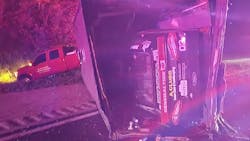At around 1 a.m. on the morning of Aug. 2, a driver hauling Clubb Racing’s #03 Ford stock car fell asleep and crashed into the median, causing the trailer carrying the small family-owned team’s #03 car to flip. The incident occurred after the ARCA Menards Series race at the Iowa Speedway. The driver, a friend of team owner Alex Clubb, was going eastbound on Interstate 80 in a dually truck. He was about an hour away from the shop in Morris, Illinois.
No one was injured, according to Clubb, though several tractor-trailers reportedly hit the overturned trailer. This caused severe damage to the equipment and the racecar inside. Clubb Racing estimates the total damage for the truck, trailer, and car at $80,000. This includes an $8,000 tow bill. A GoFundMe campaign for $25,000 was opened to help the lean racing team offset repair costs and stay in operation. The goal was at 66% as of Aug. 5.
The #03 car was turned on its side for nine hours, causing oil to leak into the motor, in addition to body and suspension damage. As of Aug. 4, the damaged car was 85% fixed. The car might not be ready for the next race, and the team's #85 car would run as the #03 car, Clubb said.
Clubb explained that after the race, in which he finished in 20th place, the team had dinner at Iowa 80 Truckstop (which does not sell alcohol) before heading back to Illinois.
“I take full responsibility for it, because we usually have a buddy system when we travel,” Clubb said in a Facebook post.
Clubb noted that typically, when drivers are alone in the truck, they call each other every 15 minutes to keep alert, and when a driver is tired, they pull over to rest. Clubb, who was in another vehicle, said he was asleep at the time of the accident.
Our takeaway
The total trip down I-80 is about 250 miles, or only about four hours. Seasoned professional truckers can do that stretch without blinking, but it’s important to note this is basically a small business where the team was out in the sun doing exhaustive work. The race was 150 laps, with drivers going above 90 mph.
Clubb noted the team usually has checks in place to ensure fatigue is not an issue, but accidents typically don’t happen when everything goes according to plan.
That is why even small businesses should look into a more reliable buddy system: a fatigue detection system. This refers to AI-enabled software running through an inward-facing dashcam that identifies certain behavior associated with drowsy driving. This may include head nodding and heavy eyelids. If this behavior continues, the system will generate an audible alert. Businesses can even set up a fleet manager to receive text alerts to intervene, such as telling the driver to pull over at a rest stop.
About the Author

John Hitch
Editor-in-chief, Fleet Maintenance
John Hitch is the award-winning editor-in-chief of Fleet Maintenance, where his mission is to provide maintenance leaders and technicians with the the latest information on tools, strategies, and best practices to keep their fleets' commercial vehicles moving.
He is based out of Cleveland, Ohio, and has worked in the B2B journalism space for more than a decade. Hitch was previously senior editor for FleetOwner and before that was technology editor for IndustryWeek and and managing editor of New Equipment Digest.
Hitch graduated from Kent State University and was editor of the student magazine The Burr in 2009.
The former sonar technician served honorably aboard the fast-attack submarine USS Oklahoma City (SSN-723), where he participated in counter-drug ops, an under-ice expedition, and other missions he's not allowed to talk about for several more decades.

